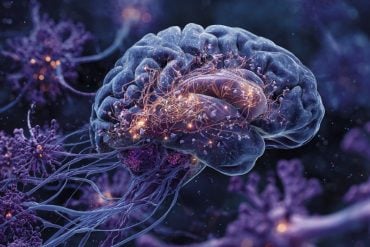Summary: Octopuses, despite their completely different brain structures, display sleep cycles akin to humans.
The research reveals octopuses enter an active sleep phase similar to REM sleep in humans, suggesting the existence of this sleep stage in complex cognition across species. Scientists also found that disruption in sleep prompts octopuses to reenter this active stage more frequently, underscoring its necessity.
Lastly, changes in the octopuses’ skin patterns during this active sleep phase suggest they could be ‘dreaming’ in their unique way.
Key Facts:
- Octopuses display an active sleep stage that resembles REM sleep in mammals, suggesting this sleep phase has independently evolved in creatures with complex cognition.
- Disturbance in sleep causes octopuses to enter this active sleep phase more frequently, highlighting its importance.
- During this active sleep phase, octopuses’ changing skin patterns imply they might be ‘dreaming’ or rehearsing their waking experiences.
Source: OIST
When octopuses sleep, their quiet periods of slumber are punctuated by short bursts of frenzied activity. Their arms and eyes twitch, their breathing rate quickens, and their skin flashes with vibrant colors.
Now, researchers from the Okinawa Institute of Science and Technology (OIST), in collaboration with the University of Washington, have closely examined the brain activity and skin patterning in octopuses (Octopus laqueus) during this active period of sleep and discovered that they closely resemble neural activity and skin patterning behavior seen when awake. Wake-like activity also occurs during rapid eye movement (REM) sleep in mammals – the phase in which most dreams occur.

The study, published 28 June in Nature, highlights the remarkable similarities between the sleeping behavior of octopuses and humans and provides fascinating insights about the origin and function of sleep.
“All animals seem to show some form of sleep, even simple animals like jellyfish and fruit flies. But for a long time, only vertebrates were known to cycle between two different sleep stages,” said senior author, Professor Sam Reiter, who leads the Computational Neuroethology Unit at OIST.
“The fact that two-stage sleep has independently evolved in distantly related creatures, like octopuses, which have large but completely different brain structures from vertebrates, suggests that possessing an active, wake-like stage may be a general feature of complex cognition,” said author Dr. Leenoy Meshulam, a statistical physicist at the University of Washington, who helped design the research during her three month stay at OIST as a guest of the Theoretical Sciences Visiting Program.
To begin, the scientists checked whether the octopuses were truly asleep during this active period. They tested how the octopuses responded to a physical stimulus and found that when in both the quiet and active stage of sleep, the octopuses required stronger stimulation before reacting, compared to when they were awake.
The team also discovered that if they prevented the octopuses from sleeping, or disrupted them during the active phase of sleep, the octopuses later entered active sleep sooner and more frequently.
“This compensatory behavior nails down the active stage as being an essential stage of sleep that is needed for octopuses to properly function,” said Aditi Pophale, co-first author of the study and PhD student at OIST.
The researchers also delved into the brain activity of the octopuses when awake and asleep. During quiet sleep, the scientists saw characteristic brain waves that closely resemble certain waveforms seen during non-REM sleep in mammalian brains called sleep spindles.
Although the exact function of these waveforms is unclear even within humans, scientists believe they aid in consolidating memories. Using a cutting-edge microscope built by co-first author Dr. Tomoyuki Mano, the researchers determined that these sleep spindle-like waves occur in regions of the octopuses’ brains associated with learning and memory, suggesting that these waves potentially serve a similar function to humans.
Roughly once an hour, the octopuses entered an active sleep phase for around a minute. During this stage, the octopuses’ brain activity very closely resembled their brain activity while awake, just like REM sleep does in humans.
The research group also captured and analyzed the changing skin patterns of the octopuses when awake and asleep in ultra-high 8K resolution.
“By filming in such high resolution, we can see how each individual pigmented cell behaves in order to create an overall skin pattern,” said Dr. Meshulam. “This could help us create simple skin pattern models to understand the general principles of waking and sleeping patterning behavior.”
When awake, octopuses control thousands of tiny, pigmented cells in their skin, creating a vast array of different skin patterns. They use these patterns to camouflage themselves in different environments, and in social or threat displays, such as warning off predators and communicating with each other. During active sleep, the scientists reported that the octopuses cycled through these same skin patterns.
The similarities between active sleep and awake states could be explained by a variety of reasons, said the scientists. One theory is that octopuses may be practicing their skin patterns to improve their waking camouflage behavior, or simply maintaining the pigment cells.
Another intriguing idea is that the octopuses could be re-living and learning from their waking experiences, such as hunting or hiding from a predator, and reactivating the skin pattern associated with each experience. In other words, they could be doing something similar to dreaming.
“In this sense, while humans can verbally report what kind of dreams they had only once they wake, the octopuses’ skin pattern acts as a visual readout of their brain activity during sleep,” said Prof. Reiter.
He added, “We currently don’t know which of these explanations, if any, could be correct. We are very interested in investigating further.”
About this neuroscience research news
Author: Tomomi Okubo
Source: OIST
Contact: Tomomi Okubo – OIST
Image: The image is credited to Neuroscience News
Original Research: Open access.
“Wake-like skin patterning and neural activity during octopus sleep” by Sam Reiter et al. Nature
Abstract
Wake-like skin patterning and neural activity during octopus sleep
While sleeping, many vertebrate groups alternate between at least two sleep stages: rapid eye movement and slow wave sleep, in part characterized by wake-like and synchronous brain activity, respectively.
Here we delineate neural and behavioural correlates of two stages of sleep in octopuses, marine invertebrates that evolutionarily diverged from vertebrates roughly 550 million years ago and have independently evolved large brains and behavioural sophistication. ‘Quiet’ sleep in octopuses is rhythmically interrupted by approximately 60-s bouts of pronounced body movements and rapid changes in skin patterning and texture.
We show that these bouts are homeostatically regulated, rapidly reversible and come with increased arousal threshold, representing a distinct ‘active’ sleep stage.
Computational analysis of active sleep skin patterning reveals diverse dynamics through a set of patterns conserved across octopuses and strongly resembling those seen while awake.
High-density electrophysiological recordings from the central brain reveal that the local field potential (LFP) activity during active sleep resembles that of waking. LFP activity differs across brain regions, with the strongest activity during active sleep seen in the superior frontal and vertical lobes, anatomically connected regions associated with learning and memory function.
During quiet sleep, these regions are relatively silent but generate LFP oscillations resembling mammalian sleep spindles in frequency and duration.
The range of similarities with vertebrates indicates that aspects of two-stage sleep in octopuses may represent convergent features of complex cognition.







